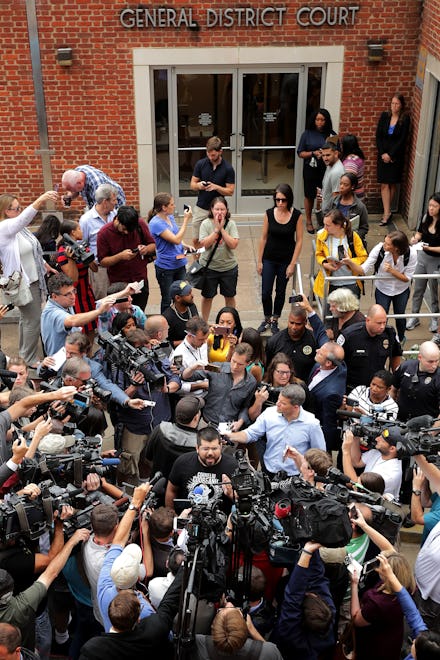Why are media outlets so fascinated by how normal Nazis are?

The New York Times published a widely panned article on Saturday profiling white supremacist Tony Hovater. The author, Richard Fausset, declined to challenge Hovater’s beliefs in any meaningful way in the course of his reporting, and failed to place Hovater’s views in any broader social or historical context.
The result is an oddly gentle portrait of a white nationalist and Holocaust denier, focused as much on Hovater’s affinity for Twin Peaks and pasta as his reverence for Adolf Hitler. Defending the piece, Times national editor Marc Lacey honed in on one criticism the article has faced in particular.
“[A] lot of readers found the story offensive, with many seizing on the idea we were normalizing neo-Nazi views and behavior,” Lacey wrote in a Sunday column. “The point of the story was not to normalize anything but to describe the degree to which hate and extremism have become far more normal in American life than many of us want to think.”
It’s unclear who Lacey includes in his “many of us” descriptor. But judging by the outcry, plenty of readers were unmoved by Hovater’s normality or the Times’ depiction of it. As they should be. The routine nature of racial segregation and terrorism in the United States over the past 250 years means that nobody should be surprised that bigots are also human beings.
Yet many media outlets remain fascinated by this perceived tension. How can a person hold such monstrous views and still be so utterly normal? This question fuels much of their reporting, yet the tension does not exist. Racial hatred has been the purview of everyday people far more often than of monsters. And in the case of the Times article, portraying Hovater as a regular guy is less egregious than assuming he’d be anything but.
In recent months, this fascination has saturated news coverage of white supremacists. Profiles of Richard Spencer and his racist cohort at Mother Jones, the Washington Post and the Los Angeles Times have all fixated on the racists’ “dapper” clothing, appreciation for good food and sharp haircuts. These descriptors are irrelevant to their beliefs. Rather, they seem intended to suggest there’s a contradiction between a controversial ethos and the uncontroversial appearance of those who espouse it.
This perception has cropped up in other conversations about racist violence as well.
“He looks like any clean-cut American kid,” Nancy Reynolds, the incredulous neighbor of Kenneth Gleason, a 23-year-old white supremacist accused of murdering two black men in Baton Rouge, Louisiana, earlier this fall, told the Associated Press in September.
Normal, clean-cut white Americans have been the lifeblood of racism in the U.S. since its inception, as I’ve written before. Respectable businessmen, doctors and lawyers comprised the resurgent Ku Klux Klan of the early 20th century. White high school and college students protested violently against the integration of their schools in the 1950s, and attacked black students trying to integrate lunch counters and other public spaces. Huge swaths of the white South defected to the Republican Party in the mid-1960s, drawn by presidential candidate Barry Goldwater’s opposition to black civil rights.
Not to mention the ways everyday people have fueled many of history’s other great atrocities, whether actively or passively. A New Yorker article by Paul Bloom on the role of dehumanization in racist violence cites Timothy Snyder’s 2016 book on the Holocaust — Black Earth — to explain how everyday Austrians participated in the humiliation of Jews under the Third Reich.
“Members of the Austrian SA ... identified Jews and forced them to kneel and clean the streets with brushes,” Snyder wrote. “This was a ritual humiliation. Jews, often doctors and lawyers or other professionals, were suddenly on their knees performing menial labor in front of jeering crowds.”
None of the people in these crowds were monsters, nor were they extraordinary in any discernible way. Like the Germans who nodded approvingly while their Jewish neighbors were stripped of their rights and sent to death camps, or white Americans captured in photographs smiling with their picnic baskets in front of lynched black corpses, they were normal human beings partaking in horrors they’d convinced themselves were OK.
This is not hard to do. It took the tenure of a black president and the racist charms of a reality TV star to install flagrant white supremacy in the White House. There are people in their early 60s today who remember living under Jim Crow. Almost every manner of anti-black violence, up to and including chattel slavery, has enjoyed either broad support or near-universal acceptance among white Americans at some point in U.S. history.
With such a wealth of historical precedent, it’s remarkable that the assumption of racism’s banality is not our baseline. This is even more notable in regards to coverage put forth by the press — an institution charged with detailing and contextualizing social phenomena in light of historical events. It remains clear that racism is the provence of ordinary Americans, and always has been. This is not a revelatory statement. And the sooner Americans accept this as a basic fact rather than new news, the sooner articles like Saturday’s Times piece can become relics of the past.